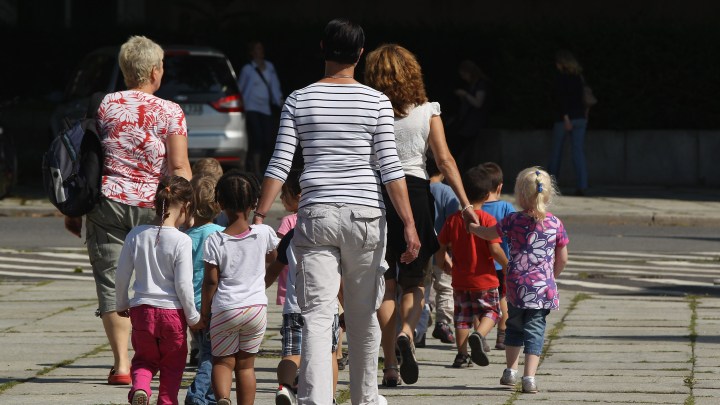
Day care providers struggle to compete with rising wages

On a recent afternoon at an early childhood education and preschool center in Hemet, California, naptime was just wrapping up in the toddler classroom.
“We need to wash hands and then you need to go potty,” said VIP Tots teacher Lauren Thomas, as she guided a 2-year-old with bedhead hair toward the classroom sink. Thomas helped the toddler lather up with soap and gently scrubbed his hands while counting out loud to 10.
Thomas was hired here at VIP Tots as a teacher in March and is just the kind of caregiver many parents want for their children. She recently earned an associate’s degree in early childhood education, has two kids of her own and really loves caring for young children.
“I love spending time with the toddlers,” Thomas said. “I love being around them. They just make me happy every day.”
But it’s hard work, and the pandemic has made the job even harder: There’s additional sanitation of toys and surfaces, trying to keep masks on children who might still be in diapers, escorting kids from parking lots instead of allowing parents inside for classroom dropoffs.
Those are some of the reasons why child care centers nationwide struggle to attract staff and teachers, but low wages might be an even bigger factor.
Most early childhood caregivers and teachers don’t earn a living wage. Up to 98% of all occupations pay more than early childhood education jobs — they’re on par with dog walkers and fast food workers, according to analyses by the Center for the Study of Child Care Employment, at the University of California, Berkeley.
Lauren Thomas said she knows there are better-paying jobs out there.
“There is, but I rather would be here,” she said. “I’m here to teach the children — be with them and educate them.”
There are two teachers for seven toddlers in Thomas’ classroom. Early childhood experts say small class sizes are necessary, and one reason day care can cost more than $17,000 a year.
The cost makes sense, said Caitlin McLean with the Center for the Study of Child Care Employment.
“We shouldn’t be trying to make this a cheap service,” McLean said, pointing out that between 0 and 5 years of age are an important time for child development, and you want teachers who are trained and certified.
That’s one reason she said it’s hard to square the fact that early childhood care and education costs parents so much, while the job of caregiving and teaching young children is one of the worst-paid jobs that you can have in America.
Meanwhile, hourly wages in other sectors, like hospitality, warehouse work and retail are going up.
“And that’s just really hard to compete with,” said Jared Dobbins, the executive director of VIP Tots. He’s been trying to recruit new teachers for months and even paid a staffing service to help. His teachers earn between $15 and $20 an hour, depending on their background and certifications. He’s had some applicants, but not enough; plus, some don’t take his offers.
Most of VIP Tot’s funding comes from fixed government subsidies, so there’s no wiggle room in his budget to increase wages.
“You are kind of hamstrung, just in terms of the ability to do significant increases to pay,” Dobbins said.
Staffing and compensation have long been a challenge for child care centers. A recent national survey showed 80% of them are short-staffed. But if the child care system was barely holding together before, it completely fell apart during the pandemic.
“It finally showed that our child care system is unworkable as it currently exists. And as it’s currently funded,” said Averi Pakulis with the advocacy group First Focus on Children. “Parents literally cannot work unless they have safe, healthy, high-quality places to bring their children.”
But not all parents have perfect or affordable options — and they still have to work.
The Biden administration dedicated $39 billion to stabilize child care in the American Rescue Plan. The emergency federal grants are designed to help parents and child care centers to raise teacher pay, buy cleaning supplies or attract new staff. But they’re not a long-term solution.
“The purpose of that money is really to stop the bleeding of the last year and a half,” Pakulis said.
And these grants have been slow to reach some day care centers. Only about half of all states have a way for child care centers to apply for and get the funding, according to the Department of Health and Human Services.
Congressional Democrats have bigger goals and a bigger plan for bolstering early childhood education, including financial help for parents and child care centers, increased wages for teachers and care providers, and universal pre-kindergarten for 3- and 4-year-olds. That proposal is still under debate, however, and its future is uncertain.
Meanwhile, Jared Dobbins said he’s short 13 teachers at VIP Tots right now. That creates more work and pressure on the teachers he does have — and that weighs on him.
“You see the tiredness that some of your teachers go home with every day,” he said.
So if or when his child care center gets a federal grant, Dobbins said he’ll use it for bonuses to thank the teachers who have stuck with him.
There’s a lot happening in the world. Through it all, Marketplace is here for you.
You rely on Marketplace to break down the world’s events and tell you how it affects you in a fact-based, approachable way. We rely on your financial support to keep making that possible.
Your donation today powers the independent journalism that you rely on. For just $5/month, you can help sustain Marketplace so we can keep reporting on the things that matter to you.











